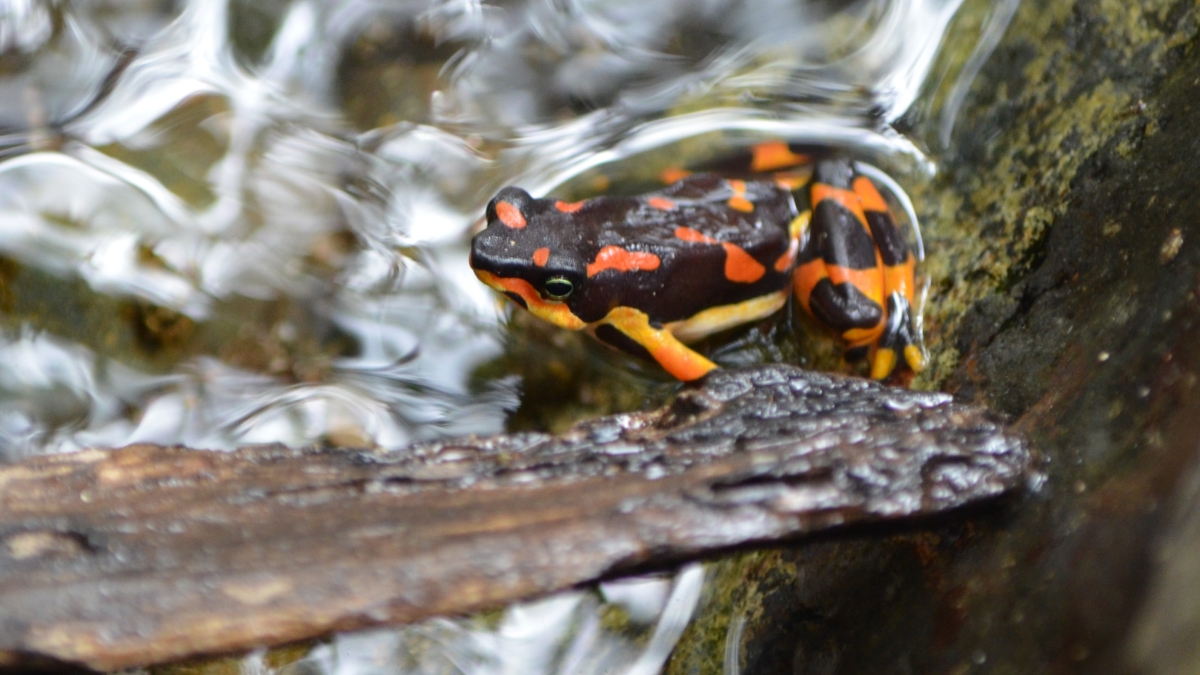Adapting gives frogs hope for survival

Atelopus varius, a critically endangered frog thought to have gone extinct after populations were decimated by the fungal disorder chytridiomycosis, was found again in Costa Rica. Conservation efforts are underway to help conserve this species. Photo by Sandra Leander/ASU
The global decline of amphibians over the past three decades is alarming, with as many as 200 amphibian species going extinct since the late 1980s. The likely cause of both extinctions and declines is the chytrid fungus — a microscopic, pathogenic fungus that causes chytridiomycosis, an infectious disease in amphibians. This disease has a wide range of effects in species, causing some to go extinct and some to decline. Meanwhile in some species it has little to no effect.
In a new study published today in Science, an international team of researchers has found that some frogs are surviving and some critically endangered species may be beginning to recover. But why?
The scientists found that changes in the chemicals released by the skin of the frogs might be helping these amphibians fight off this deadly fungus.
ASU Now spoke with James Collins, an evolutionary ecologist at Arizona State University’s School of Life Sciences who published a Perspectives paper today in the journal Science, to shed some light on what might be a bit of good news for tropical frogs.
Q: With this new study, there seems to be cause for hope, at least for some frog species. Is there?
A: When the chytrid fungus (an amphibian fungal pathogen) emerged in a community of tropical frogs in Panama in 2004, some two-thirds of the 74 species there declined to critically low numbers or were presumed extinct. More than ten years later, this new study reports the recovery of 9 of these species holding out the hope that recovery is possible and that still others species will follow.
It is important to note, however, that the nine recovering species are only about 12 percent of the original number of species in the community. Many species are still missing.
Q: What is causing some of the species to recover? Are they developing a resistance to this infection?
A: The new research suggests that recovery results from changes in chemicals released by the skin of the frogs, or changes in the microbial community on the skin of frogs and the chemicals the microbes produce, or both. The researchers are uncertain about how these changes in amphibian defenses arose. It could be that the arrival of the new pathogen stimulated successive generations of frogs to produce different chemicals as a result of changes in their physiology, genetics or both.
James Collins, Virginia M. Ullman Professor of Natural History and the Environment, ASU School of Life Sciences
Q: Is it likely that more species will continue to go extinct, or is this an important area to learn more about in terms of conservation?
A: Some species may still go extinct, especially if they were reduced to very small population sizes by this infectious disease. In terms of conservation, these results suggest it is important to minimize other population stresses to facilitate recovery. Larger population sizes will have greater variation, which would make it more likely that a species would survive a novel pathogen.
Q: Are there any options or ways we can intervene to help protect these animals, rather than simply allowing them to naturally develop resistance to this disease?
A: One alternative is removing species from the wild and putting them into facilities, such as zoos and aquaria where the amphibian pathogen is absent. This conserves the species. However, the new research shows that such animals will not develop the protections against the pathogen that arise in field populations.
This presents conservation biologists with a dilemma: leave the animals in the field and hope they develop protection or place them in facilities. Researchers then would need to study how it might be possible to challenge species in facilities in ways that they would develop protection before being released back into the natural communities.
Q: Do you think these new findings are cause for us to be hopeful about the future of amphibian species affected by this disease?
A: The new study offers hope for a couple of reasons. First, it adds more examples to those few cases we have already of species recovering. Second, the new information about how frogs protect themselves against the infectious pathogen suggests several avenues of research for understanding how this happens.
More Science and technology

ASU-led Southwest Advanced Prototyping Hub awarded $21.3M for 2nd year of funding for microelectronics projects
The Southwest Advanced Prototyping (SWAP) Hub, led by Arizona State University, has been awarded $21.3 million in Year 2 funding…

Celebrating '20 Years of Discovery' at the Biodesign Institute
Editor’s note: The Biodesign Institute at Arizona State University wraps up its 20th anniversary with the sixth and final…

Student research supports semiconductor sustainability
As microelectronics have become an increasingly essential part of modern society, greenhouse gas emissions, which are associated…
